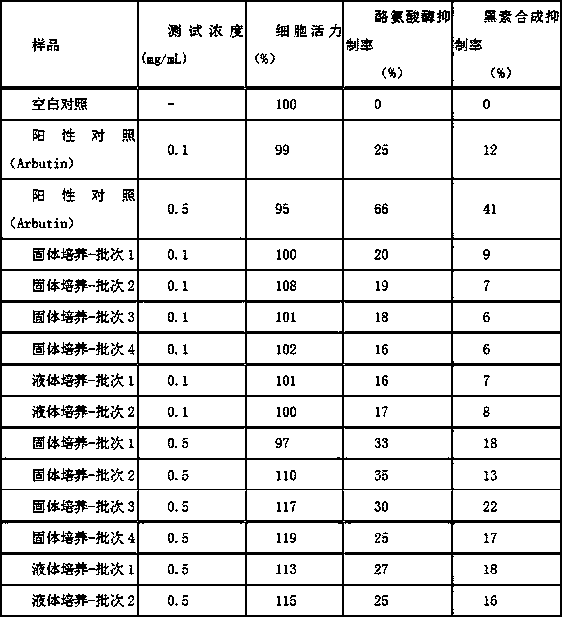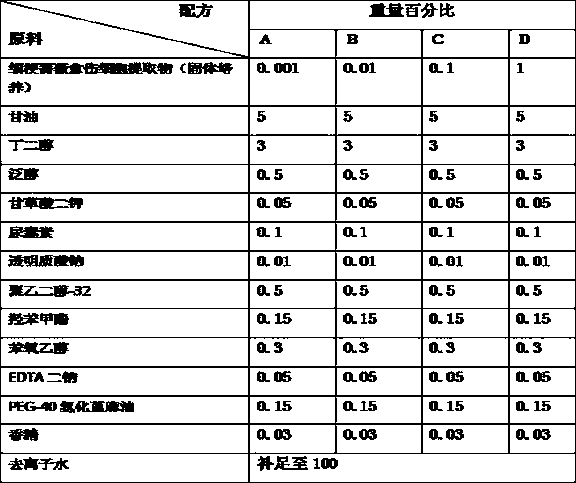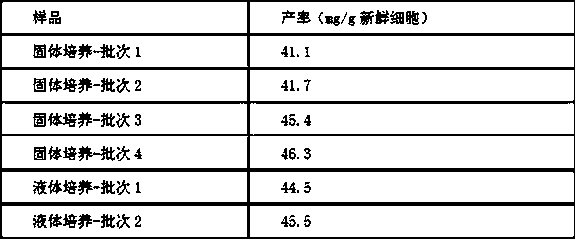Rosa graciliflora callus cell extract and application thereof in preparation of external preparation for skin
A skin external preparation and extract technology, applied in the field of plant extract application, can solve problems such as poor solubility, and achieve the effects of stable quality, short culture period and environmental friendliness
- Summary
- Abstract
- Description
- Claims
- Application Information
AI Technical Summary
Problems solved by technology
Method used
Image
Examples
Embodiment 1
[0029] Embodiment one, the cultivation of the callus of rose slender stem
[0030] 1. Solid culture
[0031] Take reagent MS medium, 2,4-dichlorophenoxyacetic acid (2,4-D), kinetin (KT), sucrose, agar, glacier water, according to the formula MS +2,4-D3.0 mg / L + KT0.5 mg / L+ sucrose 30 g / L+ agar 6 g / L to prepare the medium, adjust to pH 5.7-5.8, and sterilize in a sterilizing pot at 121°C for 20 minutes for later use. An appropriate amount of callus cells were inoculated in the culture flask. In this embodiment, 0.3-0.5 g of thin-stalked rose callus cells were selected for inoculation according to the capacity of the PC culture flask of 270 ML. The culture conditions are temperature 20±1°C, humidity 60%~75%, light intensity 1500 Lx~2000Lx, 12 hours of light per day, and cells are harvested after 20 days of culture.
[0032] 2. Liquid culture
[0033] Take reagent MS medium, 2,4-dichlorophenoxyacetic acid (2,4-D), kinetin (KT), sucrose, glacier water, according to the formula ...
Embodiment 2
[0035] Embodiment two, the extraction of callus of rose stalk
[0036] 1. Extraction of callus cells from Rosa spp.
[0037] Weigh the thin stem rose callus cells cultivated in Example 1 respectively, weigh 10g each, grind and break, add 5 times the volume of deionized water, immerse and stir, 500W ultrasonic extraction twice, each time for 30min, and centrifuge at 5000rmp for 10min , take the supernatant and filter, combine the filtrates, freeze-dry, after obtaining the extract, weigh and calculate the yield (see Table 1).
[0038] Wherein, the following batches refer to samples collected in different periods under the same experimental conditions.
[0039] Table 1 Extraction yield of callus from Rosa spp.
[0040]
[0041] 2. Determination of polyphenol content in the callus extract of Rosa spp.
[0042] The total polyphenol content was detected by the Folin-Ciocalteu method with gallic acid as the reference substance. Take 0.1 mL of gallic acid standard solution and ...
Embodiment 3
[0045] Embodiment 3, test of extract of callus cell of Rosa spp.
[0046] 1. Effect of callus extract of Rosa spp. on free radical scavenging rate
[0047] 1-Diphenyl-2-trinitrophenylhydrazine (DPPH) is a stable nitrogen-centered organic radical. The DPPH method was proposed in 1958 and is widely used in the quantitative determination of the anti-aging ability of biological samples, classified substances and food. This method is based on the fact that the DPPH radical has a single electron and has a strong absorption at 517nm, and its alcohol solution is purple. When there is a free radical scavenger, its absorption gradually disappears due to pairing with its single electron, and its fading degree has a quantitative relationship with the number of electrons it accepts. Therefore, a spectrophotometer can be used for rapid quantitative analysis to detect free radical scavenging. , so as to evaluate the anti-aging ability of the samples.
[0048] Take 0.1 mL of the extract samp...
PUM
 Login to View More
Login to View More Abstract
Description
Claims
Application Information
 Login to View More
Login to View More - R&D
- Intellectual Property
- Life Sciences
- Materials
- Tech Scout
- Unparalleled Data Quality
- Higher Quality Content
- 60% Fewer Hallucinations
Browse by: Latest US Patents, China's latest patents, Technical Efficacy Thesaurus, Application Domain, Technology Topic, Popular Technical Reports.
© 2025 PatSnap. All rights reserved.Legal|Privacy policy|Modern Slavery Act Transparency Statement|Sitemap|About US| Contact US: help@patsnap.com



